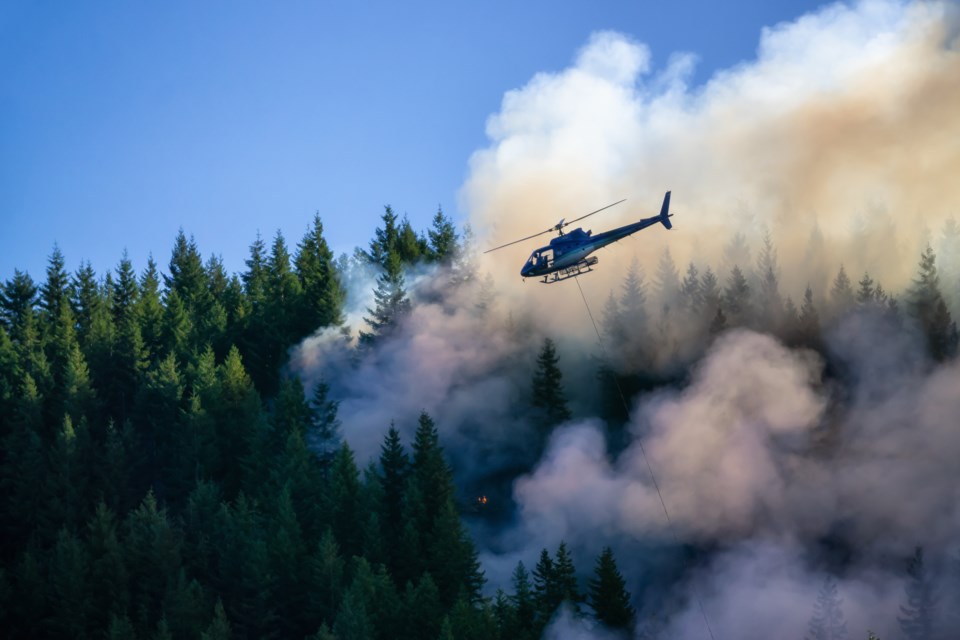Note: This story is a live file and will be updated as new information arrives. This story was last updated at 9:30 a.m. Thursday.
If you have questions or concerns you would like us to chase about northern fires, evacuations or anything else, please notify us at [email protected].
Anyone seeking to register with the Red Cross or to donate to their campaign can do so at https://www.redcross.ca/2025manitobawildfires or 1-800-863-6582.
Snow Lakers are heading back out of town today. The community is now under its second mandatory evacuation of the summer due to recent nearby fire activity.
The Town of Snow Lake announced first a voluntary evacuation Wednesday afternoon, followed by a mandatory evacuation order later Wednesday night. All people living in the community have been asked to get out by noon Thursday.
"You must leave because of the danger to your health and safety," reads the Town's announcement.
Everyone getting out of town is asked to take money, pets, medication, clothing, hygiene items, important documents like birth certificates, passports or credit cards, baby food and other item. People are also being asked by the Town to turn off their water and all lights and appliances and lock their doors, but to not turn off their furnaces.
Town officials have asked all residents to report to the Leila Soccer Complex on Leila Avenue in Winnipeg if they need assistance or lodging, but to look for shelter with loved ones if possible - with several other northern communities still evacuated and most residents staying in Winnipeg, hotel space in the city is almost nonexistent.
"All residents are strongly urged to shelter with family and friends if possible - know that if shelter is needed, you will be staying at the soccer complex on cots, as there are no available hotel rooms in Winnipeg," reads the announcement from the Town.
Three separate fires have been reported through the Snow Lake area in the past 10 days, each sparking up due to lightning. One fire is already considered “under control” by the Manitoba Wildfire Service, but two are still listed as “out of control” as of Monday night - a 3,000 hectare blaze north of Reed Lake first found July 1 and a 4,400 hectare one northeast of town first found July 2.
It's the one near Reed Lake that's caused most of the recent grief around Snow Lake. Strong winds from the south Wednesday pushed the fire to the north, edging it closer to Snow Lake and the road heading into town. The other fire near Osborne Lake also grew to the north, taking it toward territory away from populated areas.
Fire resources have been brought in to the area and are being used to fight the flames on both fronts, including a group of firefighters from Mexico's National Forestry Commission (Conafor) who came up to work after being stationed in Flin Flon. The road to Osborne Lake to the northeast was closed after the junction to the Snow Lake Airport as of July 5.
Snow Lakers were first evacuated from the area June 6, due to the growth of the great northern fire and other burns that could potentially close off highway access into the region. People were able to return home June 14, but much like for Flin Flon, locals were told to keep a bag backed just in case.
According to Natural Resources Canada, the entire region has either a "moderate", "high" or "extreme" fire danger as of Thursday morning, depending on location. A thunderstorm system brought heavy rain into the area Wednesday night, but also lightning strikes - it is not yet known if the lightning caused any new fires.
Hotspots have been reported with several fires so far this week, including the great northern fire that has affected communities stretching from Pelican Narrows to Sherridon, including Flin Flon, Creighton and Denare Beach. The hotspots and fire activity were pushed to the north after high winds and dry conditions Wednesday, with the northern fire now a risk to not only join with several other small fires but also the WE025 fire near Pukatawagan, which also saw growth Wednesday.
Flin Flon
New flareups have been found with the great northern fire, according to hotspot data from multiple mapping and data sources. Both Natural Resources Canada and NASA/FIRMS mapping show that a new cluster of hotspots, located by Deadhorse Lake about 10 kilometres northwest of Creighton, was found last weekend - the flare-up is still showing signs of life Thursday.
The hotspots are not complete indicators that the fire has rekindled and they have only been reported, as of The Reminder’s press time, within the reported perimeter of the existing fire. No reports of property damage have been made in connection with the flareup, but fire attack helicopters and other aircraft could be seen flying over Flin Flon throughout the weekend and early this week towards it to limit spread.
Other portions of the fire, burning in more remote areas, have also reported clusters of hotspots in recent days. The two largest have both been in the fire's northeast side, with two major growth areas - one north of Burntwood Lake northeast of Sherridon, another near Girouard Lake northwest of Sherridon and southwest of Pukatawagan.
The fire is still considered to be “out of control” by the Manitoba Wildfire Service. In a July 7 Manitoba government fire update, officials said that containment of the fire around different area communities is still strong, but to expect intermittent smoke and flare-up activity as weather dries out and warms up this summer.
“Good containment is in place in the immediate vicinity of the communities. Work continues to address hot spots and as things dry out, we do expect to see more smoke popping up in areas of this very large fire complex,” said Kristin Hayward, Manitoba’s assistant deputy minister in responsible for the Manitoba Wildfire Service.
According to Natural Resources Canada, the fire has a total perimeter estimate of over 520,000 hectares - that number has grown in the past two days. The Manitoba Wildfire Service reports the fire’s area as just over 370,000 hectares, but it is unknown if that counts portions of the fire that burnt in Saskatchewan.
Air quality alerts and advisories have been issued intermittently through the past week for the area by Environment Canada due to the ongoing smoke. A special air quality statement had been issued for Flin Flon, Cranberry Portage and Grass River Provincial Park on the Manitoba side and Creighton, Denare Beach, the Hanson Lake Road and all nearby areas in Saskatchewan as of Monday night and was still in effect Thursday. According to Environment Canada, there is no rain in the forecast during the coming days, but a 30 per cent chance of showers Thursday night and rain expected late Sunday through Monday.
Thompson
The fire situation near Thompson has also been touch and go, but while the community is under a local state of emergency, no evacuation orders have yet been announced. A local state of emergency was called for the north's largest city as a precaution July 7 due to a growing fire northeast of town. The NO061 fire, first found July 4 and suspected to be natural in origin, has now affected almost 6,000 hectares of land as of Thursday morning according to the Manitoba Wildfire Service. The fire has burned across Highway 280, the road to Split Lake/Tataskweyak Cree Nation and Gillam - Split Lake/Tataskweyak is already the site of a growing fire that burned down seven homes in the area earlier this week.
According to the City of Thompson, fire crews are working on extinguishing hotspots and with bulldozers were being brought in to create a guard line between the community and the fire. A backburn was planned for the area Tuesday, meant to remove trees south of the fire site, but high winds in the area forced that plan to change, then kiboshed the plans again Wednesday.
"Value protection equipment continues to be set up at Mystery Mountain Winter Park, the golf course and the horse stables as well as at the airport fuel tank farm and at tank farms out by the industrial area and railway station," reads a statemenf from the City of Thompson issued July 9.
People in Thompson have been asked to complete a preplanning registration form at the City's website, found at www.thompson.ca, in case an order is made to evacuate.
Lynn Lake and Leaf Rapids each did their own fire evacuation last week. Lynn Lake issued a mandatory evacuation notice late July 3, with a nearby fire that started June 30 potentially threatening the town’s supply of electricity. The fire, which began south of town, has grown to about 9,500 hectares in size according to Manitoba Wildfire Service and is listed as “out of control”.
“All residents are required to evacuate to ensure personal safety,” reads the notice.
People began leaving the next morning en route to Brandon, where an evacuation centre was set up at the Victoria Inn. Some locals took their own vehicles, while buses and flights from the community’s airport were also sent to accommodate anyone in need of getting out.
About 600 people call Lynn Lake home, most of whom headed away for the second time this summer. In mid-May, the community issued a different evacuation order as a different fire, which is still considered “out of control” by the Manitoba Wildfire Service, burned close to town. That fire burned over 80,000 hectares of land, including territory within two kilometres of town, but no structures have been lost within town limits and no injuries have been reported.
Meanwhile, Leaf Rapids called their own evacuation order July 7 as a different fire, which started after a lightning strike June 27, threatens to possibly burn across the road in and out of town. All residents of Leaf Rapids, about 350 of them according to the last federal census, were asked to get out of town by 10 a.m. Tuesday.
“The Town of Leaf Rapids has declared a state of local emergency because of forest fire. You must leave because of the danger to your health and safety,” reads a statement issued by the Town July 7.
Evacuees from the community were asked to head to Winnipeg, at the Leila Avenue soccer complex. Buses were brought in to take people away starting Tuesday morning and hotel rooms were being booked up for people in need of a place to stay.
“We appreciate going through an evacuation is never easy. Thank you for your cooperation and understanding,” reads the Town’s statement.
Christine Stevens, the assistant deputy minister responsible for the Manitoba Emergency Management Organization (EMO), said six communities were evacuated as of Monday, soon to be eight including Leaf Rapids and Snow Lake - Lynn Lake, the nearby Black Sturgeon Falls/Marcel Colomb First Nation, Split Lake/Tataskweyak Cree Nation and Pukatawagan/Mathias Colomb Cree Nation (which has still been evacuated since May 28), Nopaming Provincial Park near the Ontario border and a cottage subdivision at Wallace Lake near Nopiming.
Flin Flon, Creighton and Denare Beach is not under any direct threat from any nearby forest fires as of July 10.




